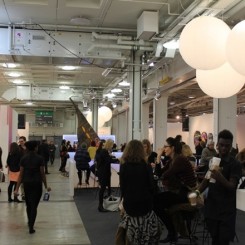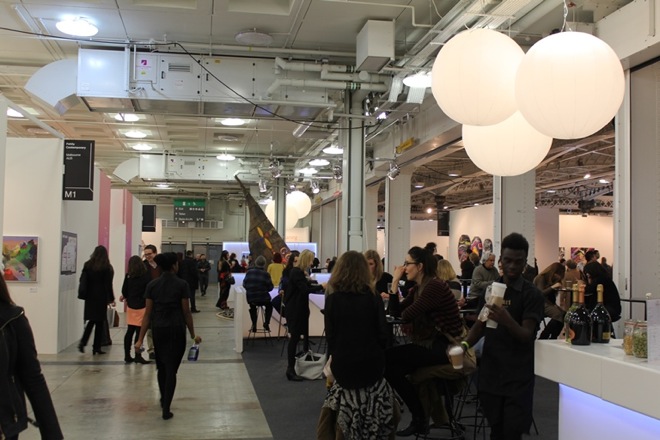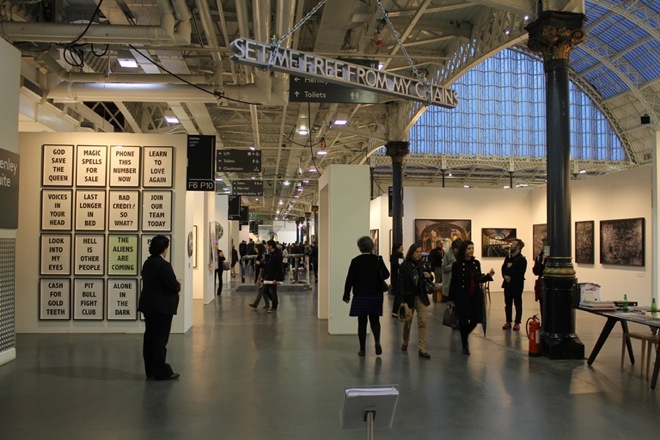A quick glance at the body language of gallerists in their booths on the closing day of Art14 made clear that last year’s levels of satisfaction had not been matched in the second edition of the global London fair.
Amongst galleries Randian spoke to, consensus on sales was absent. Alexander Ochs Galleries enjoyed the strongest sales (plain to see from an ebullient Mr Ochs), including Zhao Zhao’s “Throne”. At Hong Kong’s Galerie du Monde, Li Hao and Qin Feng did well, with total sales over GBP 100,000. Emerging London gallery, Edel Assanti sold almost everything from their Gordon Cheung solo-presentation (one major international collector left empty-handed because the work they really liked was already sold). London-Zurich gallerist Kashya Hildebrand, noted particularly for emerging market artists, commented she was happy with the outcome of the fair, saying:
“It was a very good international eclectic mix of collectors and we made some good contacts. I saw very few English collectors but there were enough expats traveling through the fair. For us as a local gallery it was well worth our time and I am happy I participated.”
Meanwhile leading Taipei gallery, Lin & Lin said sales were middling. Smaller galleries with relatively less expensive works perhaps had more scope for sales. At least one major gallery director, while stating that she loved the presentation, questioned whether it was the right match for her gallery. One called it “so-so” and another complained about a want of collectors. It seemed overall that expectations (perhaps based on the relative success of the first year), had not been met.
Alongside these complaints, however, were observations of a lot of “good energy”. Certainly, the fair did not suffer from a lack of visitors—quite the opposite on opening night, with booths too crowded to sell (a common complaint from gallerists—they are a hard to please bunch). The opening was packed, and the weekend saw throngs of people moving through the doors flanked dramatically by Zhao Zhao’s waxed waterfall and Yinka Shonibare’s cannonball installation. The quality of the displays and projects was high, with some very well-designed commercial booths and projects providing mutual support. Like last year, the general look and feel of the fair was vibrant and engaging. One had the sense of being able to find work of good quality, and in addition, prices ranged from the very affordable (etchings for £350), to higher end (Pearl Lam’s expansive display at the front of the hall). Big names like White Cube, Long March Space and Pace were again not in attendance, but this didn’t necessarily feel like a loss.
In hindsight, this closing mixture of sellers’ ennui and spectators’ energy may be what sums up this second edition of Art14, its context and challenges. A large portion of the London public is mobile and interested in cultural events. A well-presented “global” fair like Art14 attracts high numbers of visitors interested in contemporary displays in a concentrated locale, which is what a fair offers; this is the sort of audience mobilised very effectively in recent years, for example, by Tate Modern.
Whilst these conditions boost the atmosphere, the challenge remains for Art Fairs London—the company behind Art14—to ensure that this is a financially viable opportunity for the far-flung galleries they aim to serve and will this be affected by, say, wider aisles (thus fewer galleries but better high-value presentation) and a more stringent selection policy (fewer emerging galleries)? Or more seriously (also for The Armory Show, on this week), the fact that Art Basel Hong Kong will be held two-months earlier from March 15-17. This fair is without doubt a timely addition to the commercial landscape in London; if serious buyers can be secured alongside an interested public and good-quality content, then the fair’s long-term potential could be sealed.



